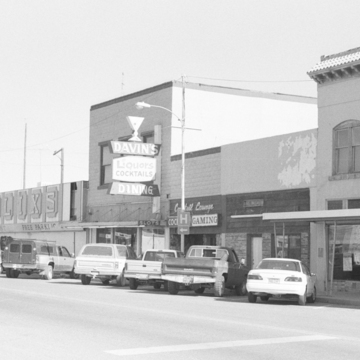From the railroad tracks, Main Street runs northwest for two blocks, terminating at the Pershing County Courthouse. Dating from 1889 to the 1940s, the buildings along the street represent the second period of Lovelock's downtown development. During that time, banks, offices, bars, stores, a pool hall, a dance hall, and a post office lined the street. Today the businesses are less diverse, but Main Street remains Lovelock's downtown core. Despite some infill, the blocks are fairly intact, lined with simple one- and two-story structures expressing the town's modest prosperity. Most buildings retain large storefront windows and simple metal cornices along the roofline. Good examples of Lovelock's commercial buildings from the period run along the east side of the street, including the old First National Bank Building (1905), now a store; the Soroptimist Club (1925); and Davin's Dining (1926 and 1930). The old bank building and club have facades with large storefront windows on the first floor, two segmental-arched windows on the second floor, and narrow cornices above. Both facades are stuccoed; the bank's facade is scored to resemble coursed ashlar. The restaurant consists of two wood-frame structures with facades of cast concrete rock-faced blocks that originally contained the Marcucci and Brunetti Store, a pool hall, and a dance hall.
You are here
Main Street
If SAH Archipedia has been useful to you, please consider supporting it.
SAH Archipedia tells the story of the United States through its buildings, landscapes, and cities. This freely available resource empowers the public with authoritative knowledge that deepens their understanding and appreciation of the built environment. But the Society of Architectural Historians, which created SAH Archipedia with University of Virginia Press, needs your support to maintain the high-caliber research, writing, photography, cartography, editing, design, and programming that make SAH Archipedia a trusted online resource available to all who value the history of place, heritage tourism, and learning.




















